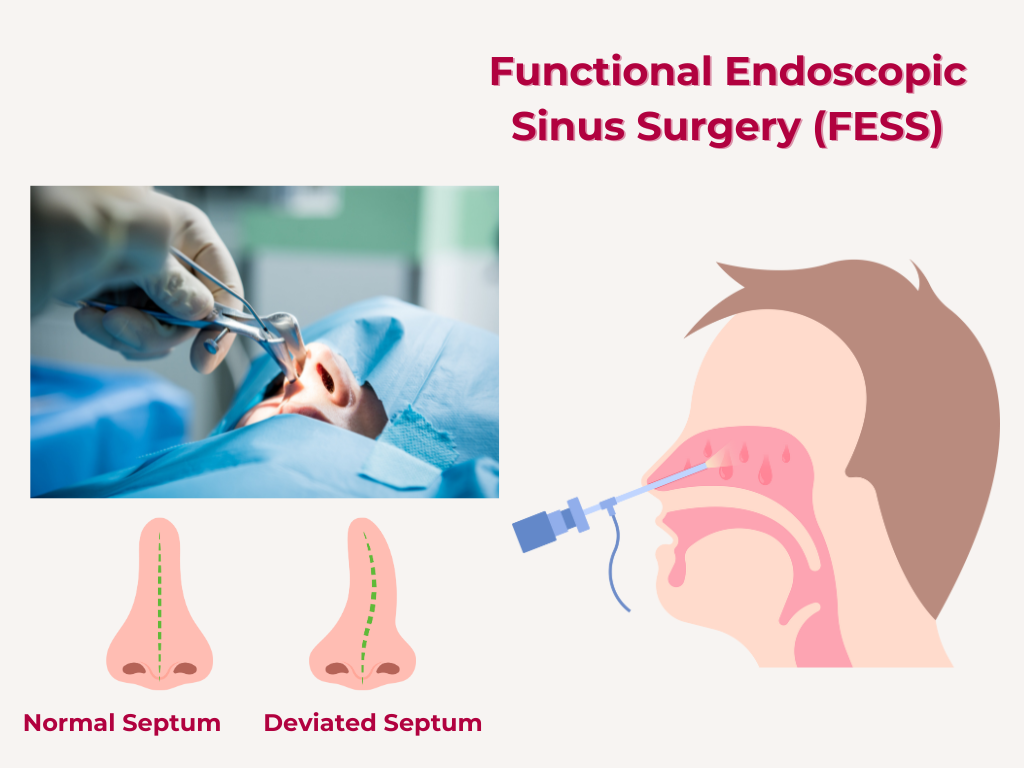Functional Endoscopic Sinus Surgery (FESS)

Functional Endoscopic Sinus Surgery (FESS) is a minimally invasive surgical technique used to restore sinus ventilation and normal mucociliary function.
It involves the use of various degrees of nasal endoscopes of various resolutions, specialized instruments like the back- biter, powered instruments like the microdebrider and drill etc.
These advanced optics and powered-instruments allow one to visualize and remove blockages, such as polyps, infected tissue, or bone, that obstruct the paranasal sinuses otia and drainage pathways. Recent introduction
of navigation technology help to improve the outcome.
Epidemiology
Chronic sinusitis, a common indication for FESS, affects approximately 12-15% of the US population. FESS is a widely performed procedure, with thousands of surgeries conducted annually worldwide.
Historical Background
FESS was developed in the 1970s and 1980s by European otolaryngologists, such as Messerklinger and Stammberger. The technique has evolved over time, with advancements in endoscopic technology and surgical instrumentation, as well as the use of navigation.
Why the Word 'Functional'?
The term "functional" refers to the goal of restoring normal sinus function, rather than simply removing diseased tissues. FESS aims to preserve mucosa and restore drainage pathways, promoting long-term sinus health.
Pathology
Common pathologies treated with FESS include:
1. Chronic sinusitis: Persistent inflammation and infection of the sinuses.
2. Nasal polyps: Benign growths that obstruct the sinuses.
3. Sinus tumors: Benign or malignant growths that obstruct the sinuses.
Pathophysiology
Sinus disease often results from:
1. Obstruction: Blockage of the sinus ostia (openings) or drainage pathways.
2. Infection: Bacterial or fungal infections that colonize the sinuses.
3. Inflammation: Chronic inflammation that contributes to tissue damage and obstruction.
4. Neoplastic causes: Benign and malignant
5. Traumatic: Accidental or iatrogenic
6. Mucociliary abnormalities: such as cystic fibrosis, Young's Syndrome, Kartegener's syndrome.
Indications
FESS is indicated for:
1. Chronic sinusitis: Failed medical management or complications.
2. Nasal polyps: Obstructive polyps or recurrent polypoid disease.
3. Sinus tumors: Diagnosis or removal of benign or malignant tumors.
Contraindications
Relative contraindications include:
1. Bleeding disorders: Patients with bleeding disorders or coagulopathy.
2. Severe comorbidities: Patients with significant medical comorbidities, such as uncontrolled diabetes mellitus, hypertension, CKD etc.
Surgery of FESS for Middle Meatal Antrostomy
Middle meatal antrostomy involves:
-
1. Identifying the maxillary sinus ostium:
Locating the natural opening of the maxillary sinus.
-
2. Removing obstruction:
Removing polyps, bone, or other obstructing tissues to open the sinus ostia and drainage pathways.
-
3. Enlarging the ostium:
Widening the opening to improve drainage.
Preoperative Preparation
1. Imaging: Reviewing CT or MRI scans to understand sinus anatomy and pathology.
2. Medical management: Optimizing medical treatment before surgery.
3. Patient education: Informing patients about the procedure and expectations and getting patient consent.
Anesthesia
FESS can be performed under:
1. General anesthesia: Suitable for most patients.
2. Hypotensive anesthesia: Reduces bleeding and improves visualization.
3. Local anesthesia: May be used for selected patients or procedures.
Position
The patient is typically positioned supine with the head elevated to about 15 to 30 degrees.
Step-by-Step Approach with Instrumentation:
1. Endoscope insertion: Introducing the endoscope into the nasal cavity.
2. Visualization: Identifying anatomical landmarks and pathology.
3. Instrumentation: Using specialized instruments 3. to remove obstruction and restore drainage.
Complications of FESS
Potential complications include
1. Bleeding: Intraoperative or postoperative bleeding.
2. Infection: Postoperative infection or abscess formation.
3. CSF leak: Rare complication due to skull base injury.
Management
Postoperative Management after FESS
1. Nasal saline irrigations: Promoting healing and reducing crusting.
2. Pain management: Controlling postoperative pain.
3. Follow-up: Regular follow-up appointments to monitor healing.
Long-term Follow-up and Decrusting
1. Regular follow-up: Monitoring for recurrent disease or complications.
2. Decrusting: Removing crusts or debris from the nasal cavity.
3. Sinus care: Educating patients on long-term sinus care and management.
Time to initiate liquid paraffin and INCS after FESS
After Functional Endoscopic Sinus Surgery (FESS), the timing for starting saline irrigation, liquid paraffin, and intranasal corticosteroids may vary depending on the surgeon’s preferences and the patient’s specific needs.
Here’s a general guideline:
Saline Irrigation
1. Start early: Saline irrigation can usually begin within 24-48 hours after surgery.
2. Frequency: Irrigate 2-3 times a day to help clear crusts, debris, and promote healing.
3. Solution: Use a sterile saline solution, either commercial or homemade (mixing salt and baking soda with water).
Liquid Paraffin
1. Start after initial healing: Liquid paraffin can be applied to the nasal cavity after the initial healing phase (around 1-2 weeks post-op).
2. Purpose: Helps to moisturize the nasal mucosa and reduce crusting.
Liquid Paraffin
1. Start after initial healing: Intranasal corticosteroids can be started after the initial healing phase (around 1-2 weeks post-op)
2. Purpose: Helps to reduce inflammation, prevent polyp regrowth, and promote long-term sinus health.
Postoperative Care
It’s essential to follow the specific instructions provided by your surgeon as they may have individualized recommendations based on your unique needs and surgical procedure.
The duration of medical treatment before and after Functional Endoscopic Sinus Surgery (FESS) can vary depending on the surgeon’s preferences and the patient’s specific needs.
Here’s a general guideline:
Preoperative Medical Treatment
-
1. Intranasal corticosteroids:
May be continued or started 2-4 weeks prior to FESS to reduce inflammation and improve surgical outcomes.
-
2. Antibiotics:
May be prescribed 1-2 weeks prior to FESS if there's evidence of acute or chronic infection.
-
3. Other medications:
May include nasal decongestants such as otrivine, antihistamines loratadine, cetirizine, or oral corticosteroids such as prednisolone or dexamethason, depending on the patient's condition.
Postoperative Medical Treatment
-
1. Intranasal corticosteroids:
Typically continued for several weeks to months after FESS (e.g., 3-6 months) to maintain sinus patency and reduce inflammation.
-
2. Liquid paraffin:
May be used for several weeks to months after FESS (e.g., 2-3 months) to moisturize the nasal mucosa and reduce crusting.
-
3. Saline irrigations:
Usually continued for several months after FESS to maintain sinus hygiene and promote healing.
Conclusion,
The duration of medical treatment will depend on the patient’s response to surgery, the extent of disease, and the surgeon’s preferences. It’s essential to follow the specific instructions provided by your surgeon.
Share Post On:
Recent Posts
-
Nuggets of ORL-RHINOLOGY
-
Nuggets of Otorhinolaryngology-Basic sciences
-
Anatomy of the Muscles of the Soft Palate
-
Ethmoidal Arteries Ligation for Epistaxis
-
Submucous Cleft Palate (SMCP)
-
Approach to Ligation of the External Carotid Artery
-
Approach to Managing a 3-Year-Old Boy with a Foreign Body in the nasal cavity.
-
Approach to Managing a 3-Year-Old Boy with a Foreign Body impacted in the ear canal.
-
Endoscopic Sphenopalatine Artery Ligation (ESPAL) for Epistaxis
-
Surgical Management of Epistaxis
-
Technique of Incision and Drainage of Septal Hematoma/Septal Abscess
-
Upper Aerodigestive Tract Foreign Body Impaction
-
Incision and Drainage of Hematoma Auris
-
Rigid Bronchoscopy for Retrieval of Foreign Bodies in Children
-
Foreign Body Impaction in the Larynx, Trachea, and Bronchi
-
Leadership Position is a Tool, not a Trophy
-
Carcinoma of the Oropharynx
-
Peritonsillar Abscess
-
Ethics of Doctor-Patient Relationship
-
Doctor-Patient Relationship Case Scenarios
-
Asymmetrical Tonsils and Approach to Evaluation and Management
-
Nasal Polyposis
-
Rigid Oesophagoscopy and Complication
-
Anatomy of Oesophagus
-
Stridor, Snoring, Stertor And Wheezing: How They Compare
-
Temporomandibular Joint (TMJ)
-
Otoacoustic Emissions
-
Tympanometry
-
Functional Endoscopic Sinus Surgery (FESS)
-
Tracheostomy
-
Clinical Voice Test (CVT) for Hearing Loss
-
Acute Epiglottitis And Approach To Management
-
Synoptic Overview Of Nasopharyngeal Carcinoma
-
Prioritizing Support For People With Disabilities Over Unhealthy Competitions That Marginalise The Downtrodden
-
Otitic Barotrauma
Categories
RELATED POSTS
Get in Touch
Read doctor-produced health and medical information written for you to make informed decisions about your health concerns.

